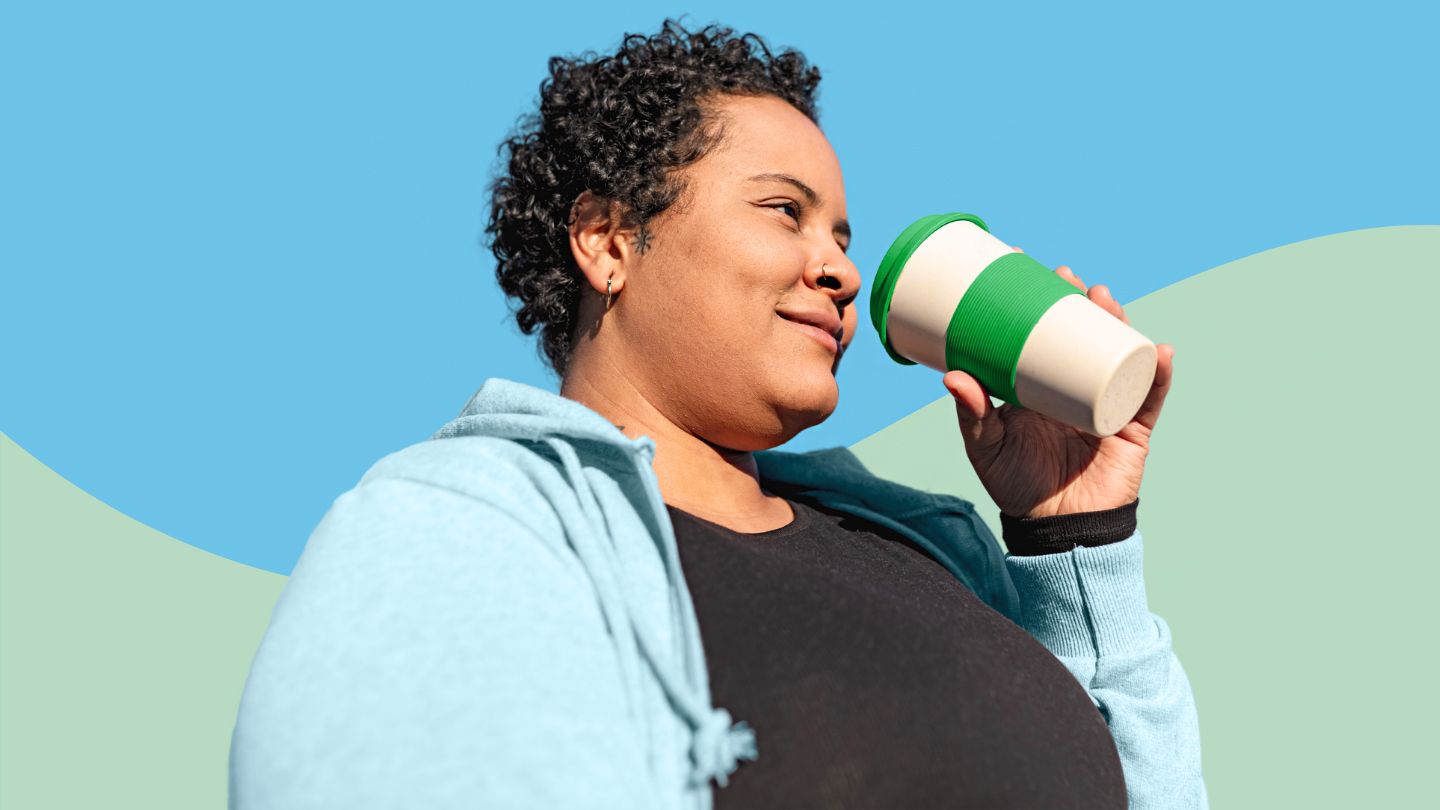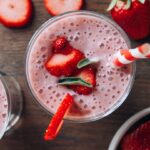1. Drink Plain Water
“Water is neutral,” Zanini says. This means that water neither raises nor lowers your blood sugar.
Water is also a great way to stay hydrated, and good hydration will help you regulate your blood sugar. “Water helps dilute your blood, which lowers your blood sugar levels,” Zanini explains.
In terms of daily fluid intake, in general, men should aim for approximately 15½ cups, while women should target about 11½ cups. But this can vary depending on your body size and activity level, as well as the weather. Consider speaking with your doctor about how much water you should aim to drink every day.
Keep an eye on your hydration by checking that the color of your urine is light yellow, Zanini says.
If you often forget to drink as much water as you should, Basbaum has a suggestion for increasing your intake: Drink one 8 ounce (oz) glass of water for every other beverage you drink that contains sugar substitutes or caffeine. Shake things up with sparkling water or by squeezing lemon or lime juice into your glass.
2. Drink Cow’s Milk, Which Also Provides Protein and Calcium
“Skim or low-fat milk is also a good beverage option, but it must be counted toward your carb total for a particular meal or snack,” Basbaum says.
A cup of low-fat (1 percent) milk also provides 307 milligrams (mg) of calcium, which accounts for about 33 percent of the recommended daily amount.
3. Avoid Sugar-Sweetened Sodas or Teas
Regular consumption of sugary drinks like soda, energy drinks, juices, and sweetened tea is associated with diabetes, heart disease, and weight gain.
But for people age 35 and older, reducing consumption of these drinks by 10 percent may decrease the incidence of diabetes.
“Sugar-sweetened drinks are absorbed into your bloodstream much too quickly, causing a spike in blood glucose levels,” Basbaum says. Furthermore, these drinks will affect your carb intake. A typical 12 oz can of soda contains about 38.5 grams (g) of carbs.
Get in the habit of carrying a bottle of water with you in case you get caught somewhere with no sugar-free drink options available.
4. Limit Artificially Sweetened Drinks, Too
Drinks with artificial sweeteners, such as diet sodas, remain a controversial topic.
On the one hand, drinks with artificial sweeteners can be a calorie-reducing alternative to sweetened drinks. “I do endorse artificially sweetened beverages for the purpose of controlling blood sugar and weight,” Basbaum says.
Whether you decide to drink artificially sweetened beverages (and how much) is a matter of taste and preference and a choice to make with your healthcare team.
5. Drink Tomato Juice Instead of Sugary Fruit Juice
If you enjoy drinking juice, or you’re tired of drinking water all the time, avoid sugary fruit options and instead opt for a small portion of vegetable juice, like tomato juice, Zanini says. And as long as you stick to 100 percent tomato juice with no added salt or sugar, it might provide you with some good overall health benefits.
Consuming a diet rich in tomatoes may protect against cardiovascular and neurodegenerative diseases. It can also improve your immune response, among other benefits. The carotenoids found in tomatoes may even lower the risk of insulin resistance.
Keep in mind that tomato juice does have nearly 11 g of carbs per cup, so you’ll need to factor that in.
As always, it’s better to eat whole fruits and vegetables than drink them, Zanini says. More than 110 g of tomato per day, or one whole tomato, may reduce blood pressure and, by extension, the cardiovascular risk associated with type 2 diabetes.
6. Drink Unsweetened Coffee and Tea
Drink hot or iced tea and coffee in moderation. “Try them either unsweetened or prepared with a sugar substitute,” Basbaum says. Your best bet is to stick to unsweetened coffee or tea, but if you have to add something, look for low-calorie sweeteners. Keep in mind that the carbs in any milk, cream, or creamer you add to your drink must be counted as part of the carbohydrates in your diet. If you enjoy syrup flavors in coffee drinks, look for sugar-free variations.
Rather than adding sugar, tea can be flavored with lemon juice. But if you need some sweetness, Zanini recommends opting for stevia instead of other artificial sweeteners as a more natural option.
Coffee and tea — green tea in particular — may lower type 2 diabetes risk.
7. Avoid Sports Drinks — Unless You’re an Endurance Athlete
Exercise is great for managing type 2 diabetes, but skip sports drinks, which are high in carbohydrates. One 12 oz serving of Powerade, for example, packs about 29 g of carbs.
Dietitians only recommend sports drinks for endurance athletes, who may exercise strenuously enough to need salt and nutrient replacement. “Sports drinks are usually not necessary unless someone has been very active for over an hour,” Zanini says.
Water is sufficient to keep you hydrated for moderate exercise. You can also plan on a healthy postworkout snack that provides you with some carbs and protein, such as a slice of whole-grain bread and tuna. These options will give you the protein and carbs you need to kick-start your exercise recovery.
8. Drink 100 Percent Fruit Juices in Moderation
An occasional 4 to 6 oz glass of 100 percent fruit juice is great as a treat, Basbaum says. Remember to count the carbs as part of your overall meal, and plan for the blood sugar spike the juice might cause.
For example, if you like to have breakfast with fresh-squeezed orange juice, which has 25 g carbs per 8 oz, calculate its nutrient makeup along with your eggs and whole-grain toast for a complete picture of the meal.
9. Drink Alcohol Sparingly
If you choose to imbibe, do so in small quantities, especially because alcohol can cause blood sugar fluctuations. Moderate drinking is defined as up to one drink for women and two drinks for men per day. One drink equals 1.5 oz of liquor, 12 oz of beer, or 5 oz of wine.
And because the benefits of alcohol are debated, if you don’t already drink alcohol, it’s best not to start. If you do drink, your doctor can advise you on how to do so safely.
10. Don’t Drink Energy Drinks, Which Contain Sugar and Caffeine
One 8.4 oz can of Red Bull energy drink contains more than 26 g of sugar and 75 mg of caffeine. Even the sugar-free version has 75 mg of caffeine. In comparison, a 1-oz shot of espresso has 63 mg of caffeine, while an 8 oz cup of coffee has 96 mg.
If you do need a quick energy boost, stick to healthier beverage options like unsweetened coffee and tea.
The Takeaway
- Water is the best choice for most people living with diabetes who need to stay hydrated because it has no carbs or calories. It helps dilute the blood and lower your blood sugar.
- Sugary drinks like soda, energy drinks, and juices can raise blood sugar quickly. Try to avoid these drinks, or consume them occasionally in small portions.
- Artificially sweetened beverages, such as diet sodas, may help reduce sugar intake. But they can also contribute to sugar cravings. Consume these drinks in moderation, and aim to opt for water instead.
- Low-fat milk, tomato juice, and unsweetened coffee or tea can all be part of a diabetes-friendly diet. But be mindful of added sugars, carbs, and portion sizes.
Read the full article here




